Corporate Financial Management Report: Portfolio Analysis, CAPM
VerifiedAdded on 2022/08/23
|11
|1752
|15
Report
AI Summary
This report delves into the core concepts of corporate financial management, focusing on portfolio decision-making processes. It begins by differentiating between the Security Market Line (SML) and the Capital Market Line (CML), illustrating their differences with graphical representations and discussing their applications in evaluating investment opportunities. The report then emphasizes the significance of minimum variance portfolios in managing market risks and determining the lower bound of the efficient frontier. Furthermore, the importance of the Capital Asset Pricing Model (CAPM) is highlighted, particularly in computing the required rate of return and assessing systematic risks associated with investments. The report also explores the assumptions underlying CAPM and its application in investment appraisal, including the computation of the Weighted Average Cost of Capital (WACC). Through the use of figures and graphical analysis, the report effectively demonstrates the practical application of these financial tools in corporate finance, illustrating how they can be used to make informed investment decisions and manage portfolio risks effectively.
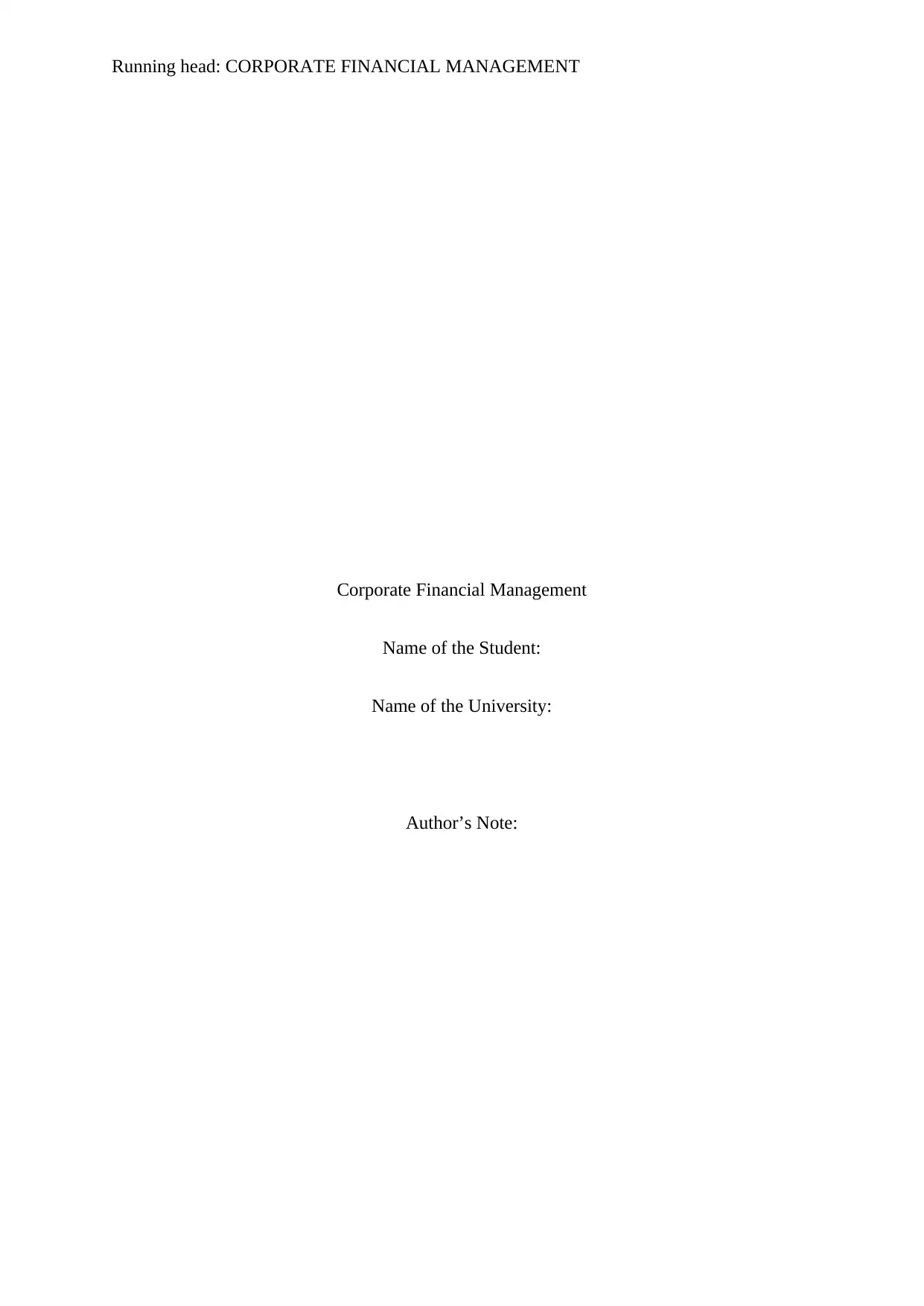
Running head: CORPORATE FINANCIAL MANAGEMENT
Corporate Financial Management
Name of the Student:
Name of the University:
Author’s Note:
Corporate Financial Management
Name of the Student:
Name of the University:
Author’s Note:
Paraphrase This Document
Need a fresh take? Get an instant paraphrase of this document with our AI Paraphraser
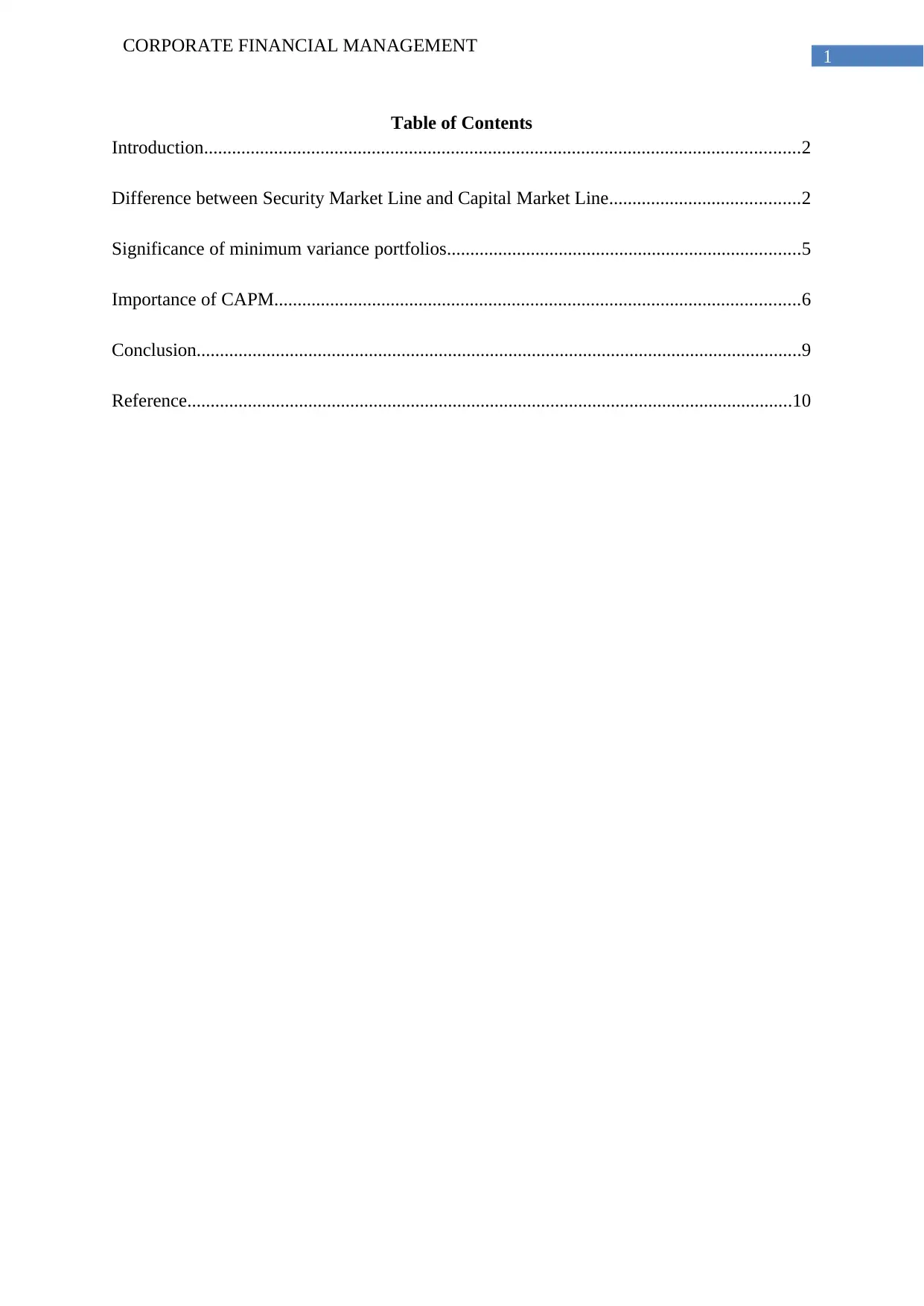
1
CORPORATE FINANCIAL MANAGEMENT
Table of Contents
Introduction................................................................................................................................2
Difference between Security Market Line and Capital Market Line.........................................2
Significance of minimum variance portfolios............................................................................5
Importance of CAPM.................................................................................................................6
Conclusion..................................................................................................................................9
Reference..................................................................................................................................10
CORPORATE FINANCIAL MANAGEMENT
Table of Contents
Introduction................................................................................................................................2
Difference between Security Market Line and Capital Market Line.........................................2
Significance of minimum variance portfolios............................................................................5
Importance of CAPM.................................................................................................................6
Conclusion..................................................................................................................................9
Reference..................................................................................................................................10
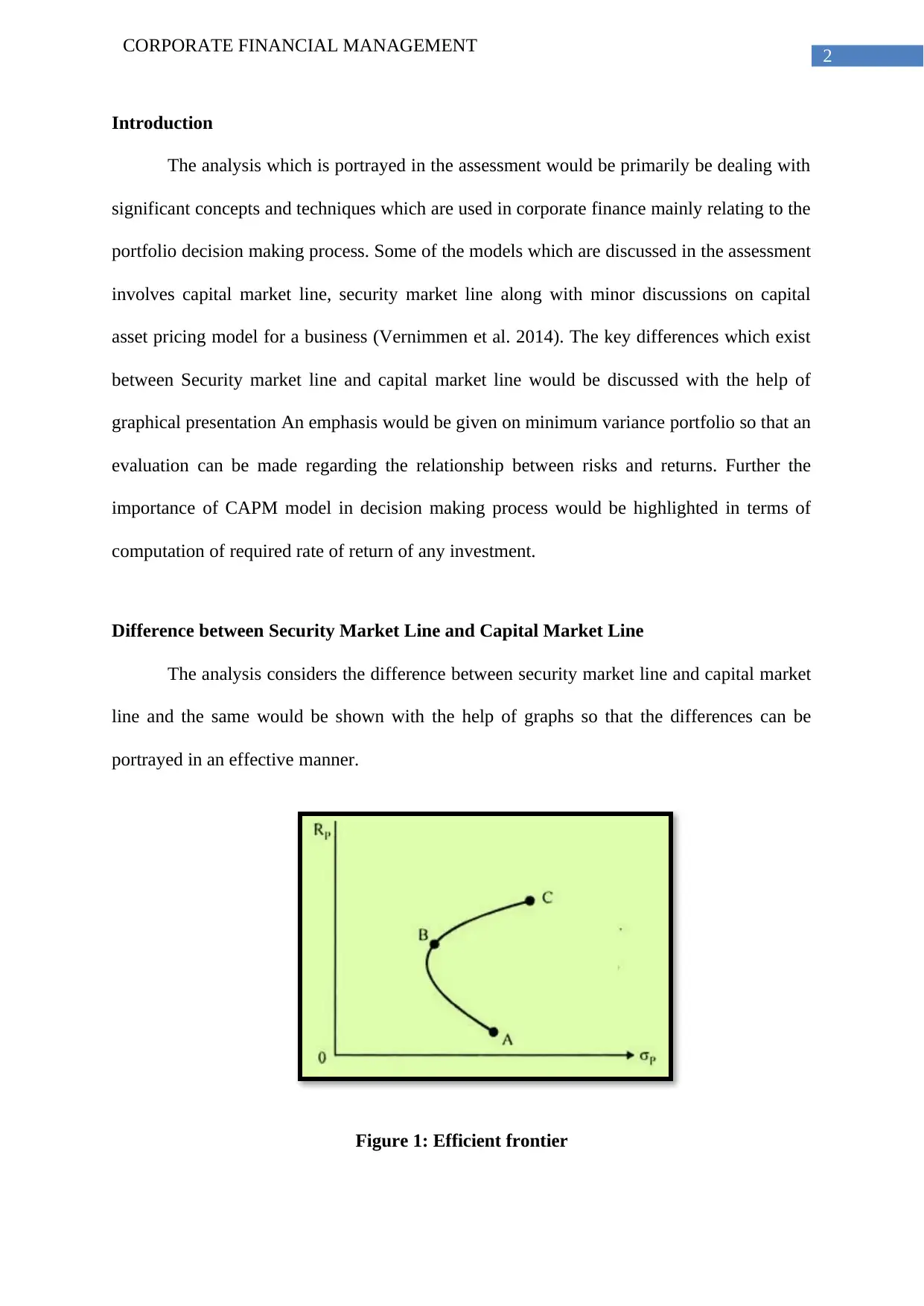
2
CORPORATE FINANCIAL MANAGEMENT
Introduction
The analysis which is portrayed in the assessment would be primarily be dealing with
significant concepts and techniques which are used in corporate finance mainly relating to the
portfolio decision making process. Some of the models which are discussed in the assessment
involves capital market line, security market line along with minor discussions on capital
asset pricing model for a business (Vernimmen et al. 2014). The key differences which exist
between Security market line and capital market line would be discussed with the help of
graphical presentation An emphasis would be given on minimum variance portfolio so that an
evaluation can be made regarding the relationship between risks and returns. Further the
importance of CAPM model in decision making process would be highlighted in terms of
computation of required rate of return of any investment.
Difference between Security Market Line and Capital Market Line
The analysis considers the difference between security market line and capital market
line and the same would be shown with the help of graphs so that the differences can be
portrayed in an effective manner.
Figure 1: Efficient frontier
CORPORATE FINANCIAL MANAGEMENT
Introduction
The analysis which is portrayed in the assessment would be primarily be dealing with
significant concepts and techniques which are used in corporate finance mainly relating to the
portfolio decision making process. Some of the models which are discussed in the assessment
involves capital market line, security market line along with minor discussions on capital
asset pricing model for a business (Vernimmen et al. 2014). The key differences which exist
between Security market line and capital market line would be discussed with the help of
graphical presentation An emphasis would be given on minimum variance portfolio so that an
evaluation can be made regarding the relationship between risks and returns. Further the
importance of CAPM model in decision making process would be highlighted in terms of
computation of required rate of return of any investment.
Difference between Security Market Line and Capital Market Line
The analysis considers the difference between security market line and capital market
line and the same would be shown with the help of graphs so that the differences can be
portrayed in an effective manner.
Figure 1: Efficient frontier
⊘ This is a preview!⊘
Do you want full access?
Subscribe today to unlock all pages.

Trusted by 1+ million students worldwide
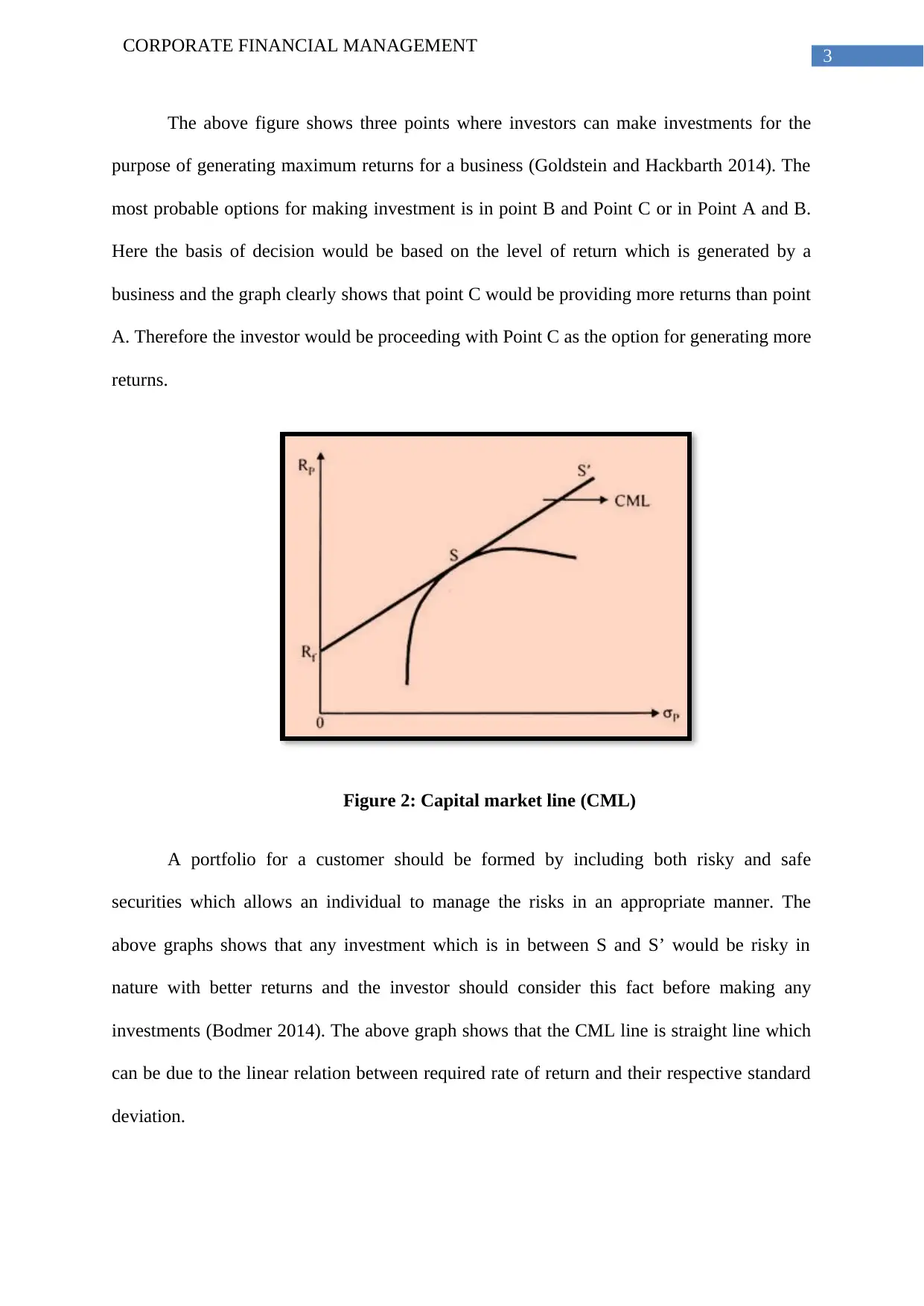
3
CORPORATE FINANCIAL MANAGEMENT
The above figure shows three points where investors can make investments for the
purpose of generating maximum returns for a business (Goldstein and Hackbarth 2014). The
most probable options for making investment is in point B and Point C or in Point A and B.
Here the basis of decision would be based on the level of return which is generated by a
business and the graph clearly shows that point C would be providing more returns than point
A. Therefore the investor would be proceeding with Point C as the option for generating more
returns.
Figure 2: Capital market line (CML)
A portfolio for a customer should be formed by including both risky and safe
securities which allows an individual to manage the risks in an appropriate manner. The
above graphs shows that any investment which is in between S and S’ would be risky in
nature with better returns and the investor should consider this fact before making any
investments (Bodmer 2014). The above graph shows that the CML line is straight line which
can be due to the linear relation between required rate of return and their respective standard
deviation.
CORPORATE FINANCIAL MANAGEMENT
The above figure shows three points where investors can make investments for the
purpose of generating maximum returns for a business (Goldstein and Hackbarth 2014). The
most probable options for making investment is in point B and Point C or in Point A and B.
Here the basis of decision would be based on the level of return which is generated by a
business and the graph clearly shows that point C would be providing more returns than point
A. Therefore the investor would be proceeding with Point C as the option for generating more
returns.
Figure 2: Capital market line (CML)
A portfolio for a customer should be formed by including both risky and safe
securities which allows an individual to manage the risks in an appropriate manner. The
above graphs shows that any investment which is in between S and S’ would be risky in
nature with better returns and the investor should consider this fact before making any
investments (Bodmer 2014). The above graph shows that the CML line is straight line which
can be due to the linear relation between required rate of return and their respective standard
deviation.
Paraphrase This Document
Need a fresh take? Get an instant paraphrase of this document with our AI Paraphraser
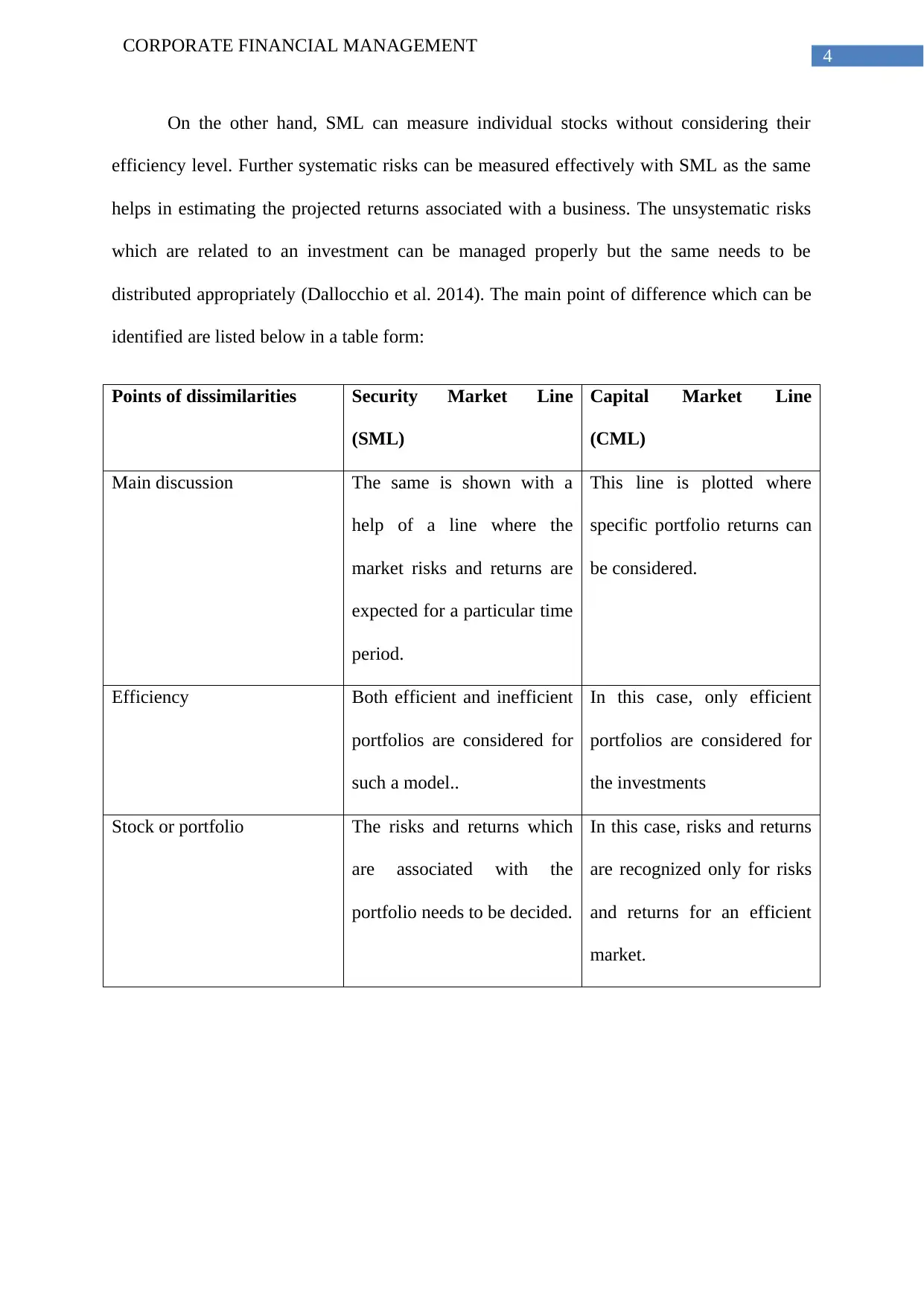
4
CORPORATE FINANCIAL MANAGEMENT
On the other hand, SML can measure individual stocks without considering their
efficiency level. Further systematic risks can be measured effectively with SML as the same
helps in estimating the projected returns associated with a business. The unsystematic risks
which are related to an investment can be managed properly but the same needs to be
distributed appropriately (Dallocchio et al. 2014). The main point of difference which can be
identified are listed below in a table form:
Points of dissimilarities Security Market Line
(SML)
Capital Market Line
(CML)
Main discussion The same is shown with a
help of a line where the
market risks and returns are
expected for a particular time
period.
This line is plotted where
specific portfolio returns can
be considered.
Efficiency Both efficient and inefficient
portfolios are considered for
such a model..
In this case, only efficient
portfolios are considered for
the investments
Stock or portfolio The risks and returns which
are associated with the
portfolio needs to be decided.
In this case, risks and returns
are recognized only for risks
and returns for an efficient
market.
CORPORATE FINANCIAL MANAGEMENT
On the other hand, SML can measure individual stocks without considering their
efficiency level. Further systematic risks can be measured effectively with SML as the same
helps in estimating the projected returns associated with a business. The unsystematic risks
which are related to an investment can be managed properly but the same needs to be
distributed appropriately (Dallocchio et al. 2014). The main point of difference which can be
identified are listed below in a table form:
Points of dissimilarities Security Market Line
(SML)
Capital Market Line
(CML)
Main discussion The same is shown with a
help of a line where the
market risks and returns are
expected for a particular time
period.
This line is plotted where
specific portfolio returns can
be considered.
Efficiency Both efficient and inefficient
portfolios are considered for
such a model..
In this case, only efficient
portfolios are considered for
the investments
Stock or portfolio The risks and returns which
are associated with the
portfolio needs to be decided.
In this case, risks and returns
are recognized only for risks
and returns for an efficient
market.
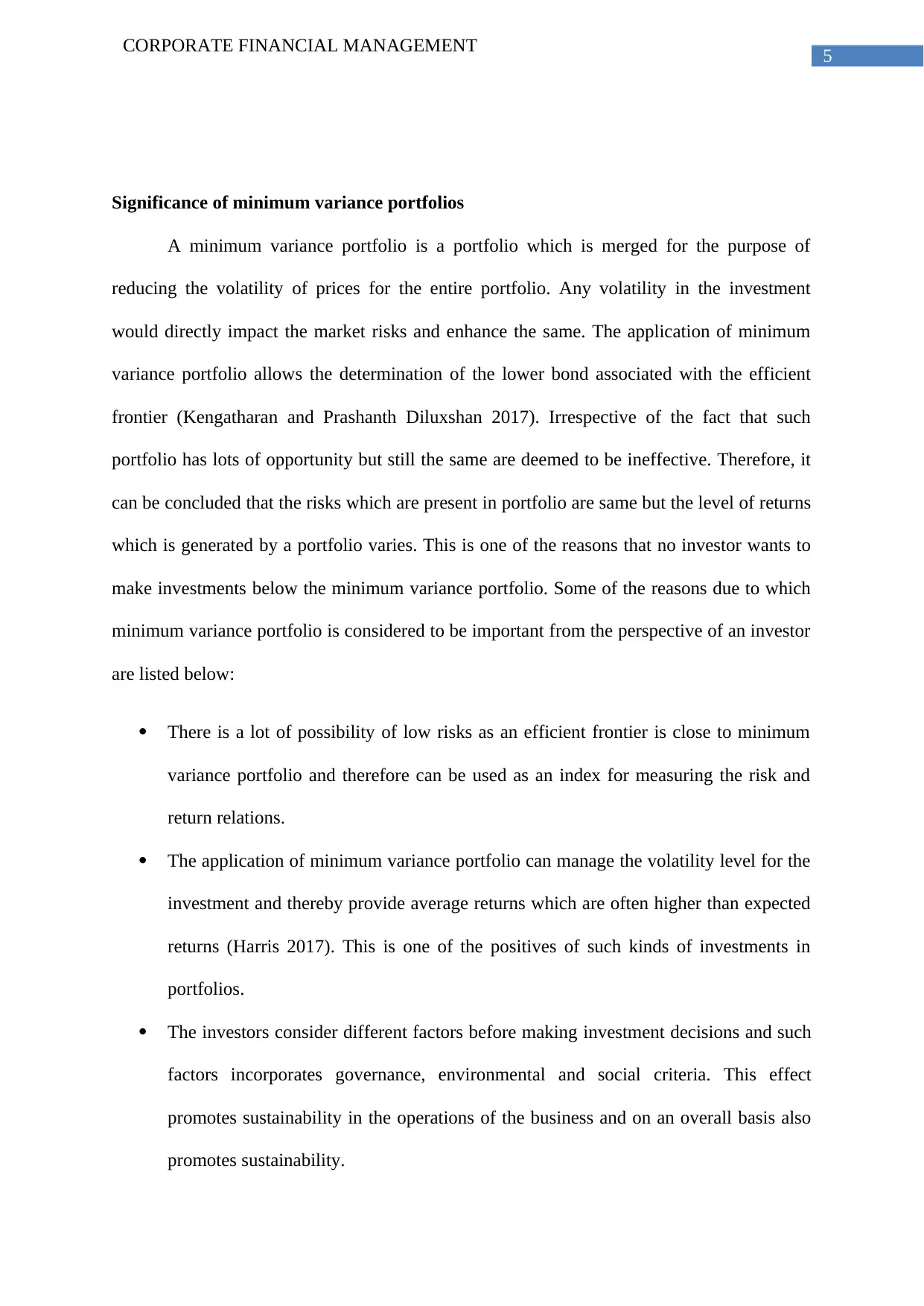
5
CORPORATE FINANCIAL MANAGEMENT
Significance of minimum variance portfolios
A minimum variance portfolio is a portfolio which is merged for the purpose of
reducing the volatility of prices for the entire portfolio. Any volatility in the investment
would directly impact the market risks and enhance the same. The application of minimum
variance portfolio allows the determination of the lower bond associated with the efficient
frontier (Kengatharan and Prashanth Diluxshan 2017). Irrespective of the fact that such
portfolio has lots of opportunity but still the same are deemed to be ineffective. Therefore, it
can be concluded that the risks which are present in portfolio are same but the level of returns
which is generated by a portfolio varies. This is one of the reasons that no investor wants to
make investments below the minimum variance portfolio. Some of the reasons due to which
minimum variance portfolio is considered to be important from the perspective of an investor
are listed below:
There is a lot of possibility of low risks as an efficient frontier is close to minimum
variance portfolio and therefore can be used as an index for measuring the risk and
return relations.
The application of minimum variance portfolio can manage the volatility level for the
investment and thereby provide average returns which are often higher than expected
returns (Harris 2017). This is one of the positives of such kinds of investments in
portfolios.
The investors consider different factors before making investment decisions and such
factors incorporates governance, environmental and social criteria. This effect
promotes sustainability in the operations of the business and on an overall basis also
promotes sustainability.
CORPORATE FINANCIAL MANAGEMENT
Significance of minimum variance portfolios
A minimum variance portfolio is a portfolio which is merged for the purpose of
reducing the volatility of prices for the entire portfolio. Any volatility in the investment
would directly impact the market risks and enhance the same. The application of minimum
variance portfolio allows the determination of the lower bond associated with the efficient
frontier (Kengatharan and Prashanth Diluxshan 2017). Irrespective of the fact that such
portfolio has lots of opportunity but still the same are deemed to be ineffective. Therefore, it
can be concluded that the risks which are present in portfolio are same but the level of returns
which is generated by a portfolio varies. This is one of the reasons that no investor wants to
make investments below the minimum variance portfolio. Some of the reasons due to which
minimum variance portfolio is considered to be important from the perspective of an investor
are listed below:
There is a lot of possibility of low risks as an efficient frontier is close to minimum
variance portfolio and therefore can be used as an index for measuring the risk and
return relations.
The application of minimum variance portfolio can manage the volatility level for the
investment and thereby provide average returns which are often higher than expected
returns (Harris 2017). This is one of the positives of such kinds of investments in
portfolios.
The investors consider different factors before making investment decisions and such
factors incorporates governance, environmental and social criteria. This effect
promotes sustainability in the operations of the business and on an overall basis also
promotes sustainability.
⊘ This is a preview!⊘
Do you want full access?
Subscribe today to unlock all pages.

Trusted by 1+ million students worldwide
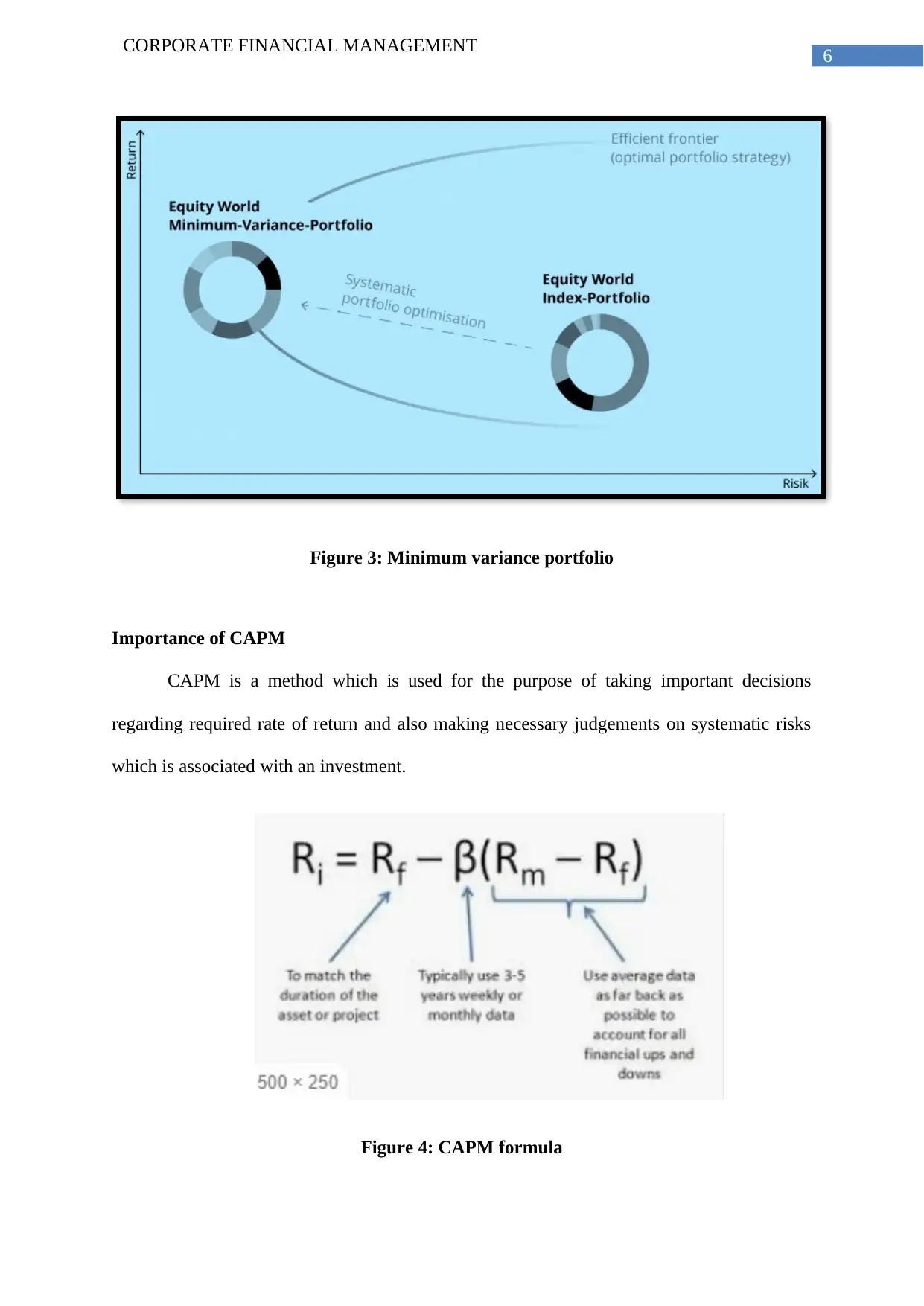
6
CORPORATE FINANCIAL MANAGEMENT
Figure 3: Minimum variance portfolio
Importance of CAPM
CAPM is a method which is used for the purpose of taking important decisions
regarding required rate of return and also making necessary judgements on systematic risks
which is associated with an investment.
Figure 4: CAPM formula
CORPORATE FINANCIAL MANAGEMENT
Figure 3: Minimum variance portfolio
Importance of CAPM
CAPM is a method which is used for the purpose of taking important decisions
regarding required rate of return and also making necessary judgements on systematic risks
which is associated with an investment.
Figure 4: CAPM formula
Paraphrase This Document
Need a fresh take? Get an instant paraphrase of this document with our AI Paraphraser
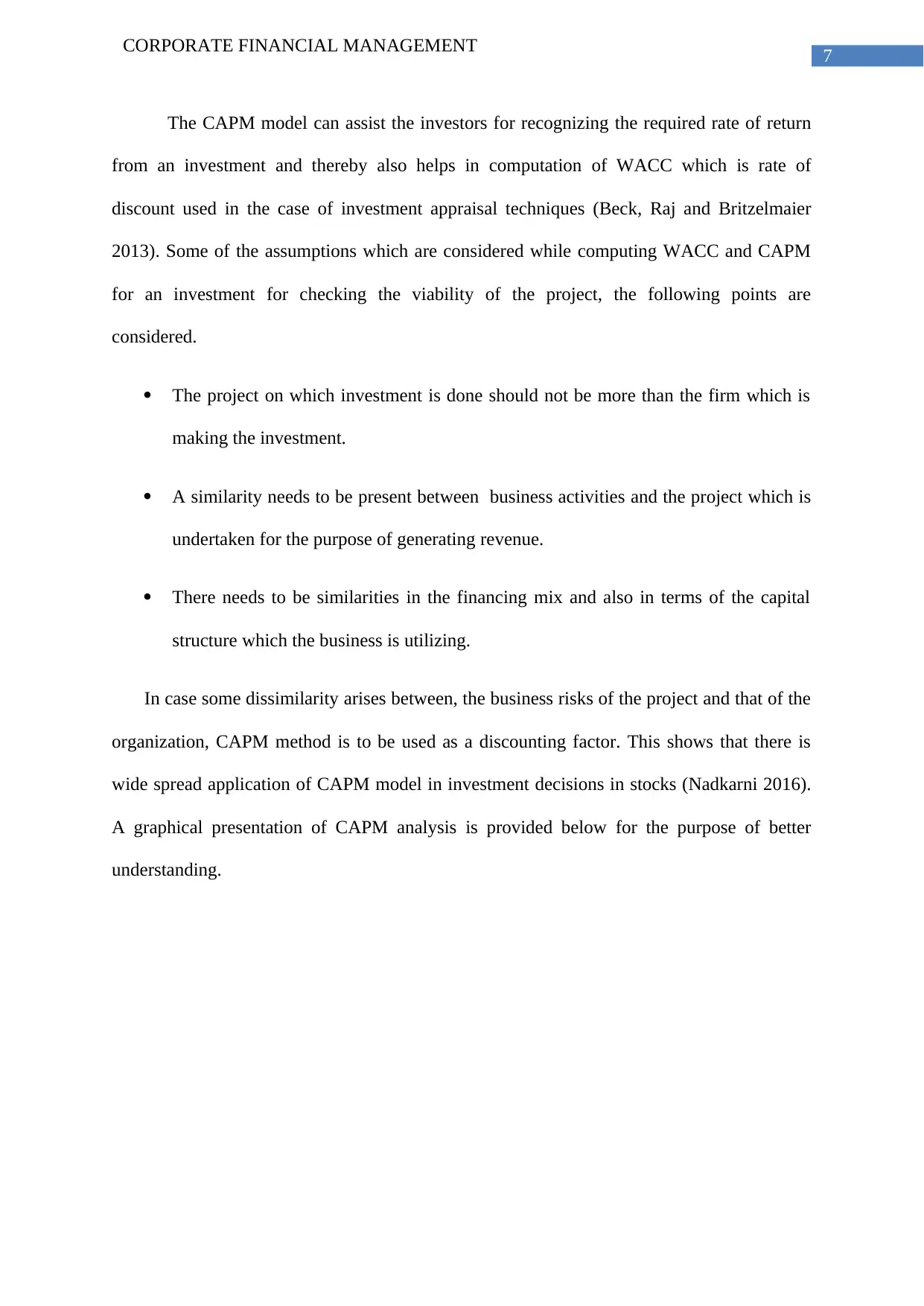
7
CORPORATE FINANCIAL MANAGEMENT
The CAPM model can assist the investors for recognizing the required rate of return
from an investment and thereby also helps in computation of WACC which is rate of
discount used in the case of investment appraisal techniques (Beck, Raj and Britzelmaier
2013). Some of the assumptions which are considered while computing WACC and CAPM
for an investment for checking the viability of the project, the following points are
considered.
The project on which investment is done should not be more than the firm which is
making the investment.
A similarity needs to be present between business activities and the project which is
undertaken for the purpose of generating revenue.
There needs to be similarities in the financing mix and also in terms of the capital
structure which the business is utilizing.
In case some dissimilarity arises between, the business risks of the project and that of the
organization, CAPM method is to be used as a discounting factor. This shows that there is
wide spread application of CAPM model in investment decisions in stocks (Nadkarni 2016).
A graphical presentation of CAPM analysis is provided below for the purpose of better
understanding.
CORPORATE FINANCIAL MANAGEMENT
The CAPM model can assist the investors for recognizing the required rate of return
from an investment and thereby also helps in computation of WACC which is rate of
discount used in the case of investment appraisal techniques (Beck, Raj and Britzelmaier
2013). Some of the assumptions which are considered while computing WACC and CAPM
for an investment for checking the viability of the project, the following points are
considered.
The project on which investment is done should not be more than the firm which is
making the investment.
A similarity needs to be present between business activities and the project which is
undertaken for the purpose of generating revenue.
There needs to be similarities in the financing mix and also in terms of the capital
structure which the business is utilizing.
In case some dissimilarity arises between, the business risks of the project and that of the
organization, CAPM method is to be used as a discounting factor. This shows that there is
wide spread application of CAPM model in investment decisions in stocks (Nadkarni 2016).
A graphical presentation of CAPM analysis is provided below for the purpose of better
understanding.
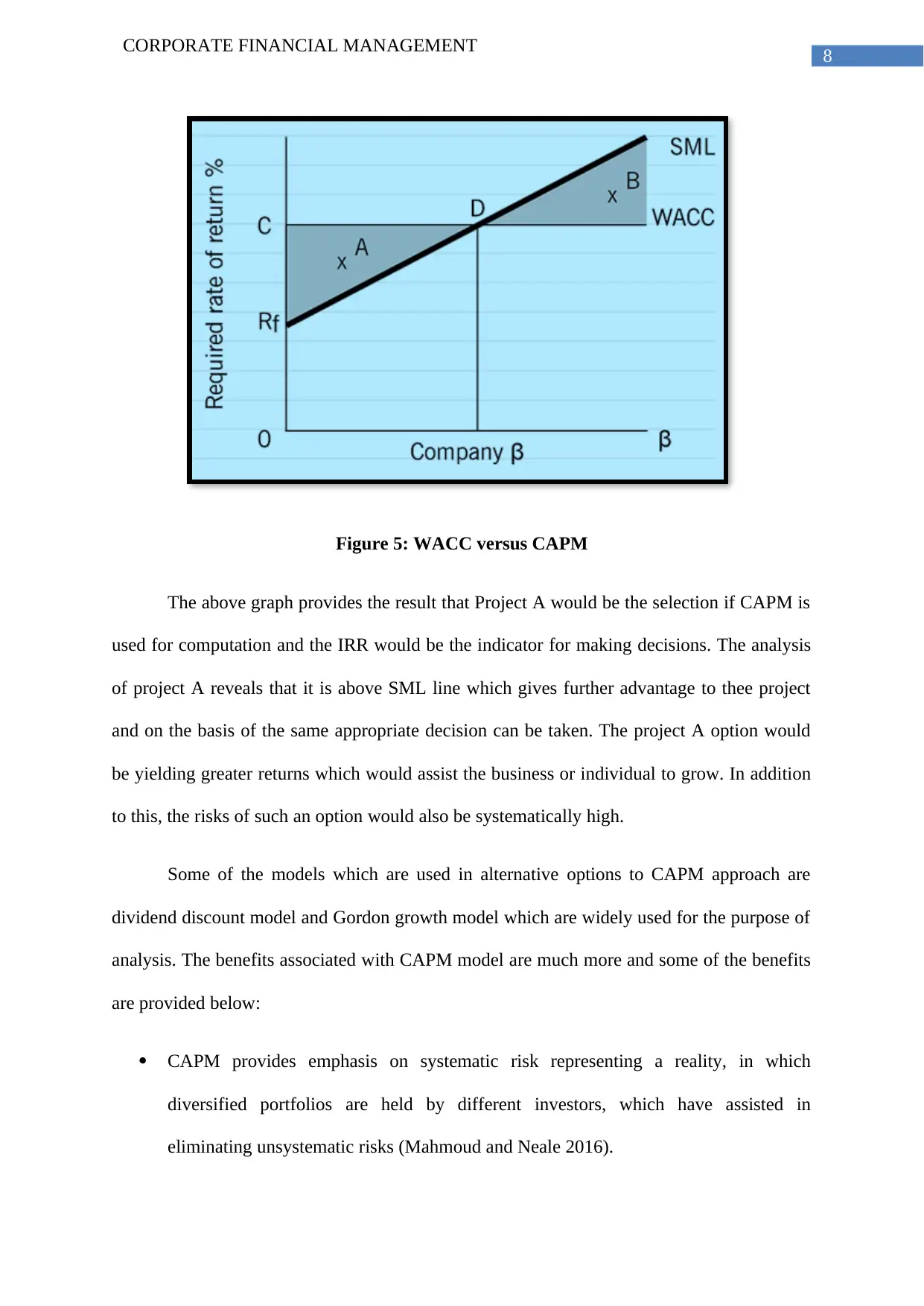
8
CORPORATE FINANCIAL MANAGEMENT
Figure 5: WACC versus CAPM
The above graph provides the result that Project A would be the selection if CAPM is
used for computation and the IRR would be the indicator for making decisions. The analysis
of project A reveals that it is above SML line which gives further advantage to thee project
and on the basis of the same appropriate decision can be taken. The project A option would
be yielding greater returns which would assist the business or individual to grow. In addition
to this, the risks of such an option would also be systematically high.
Some of the models which are used in alternative options to CAPM approach are
dividend discount model and Gordon growth model which are widely used for the purpose of
analysis. The benefits associated with CAPM model are much more and some of the benefits
are provided below:
CAPM provides emphasis on systematic risk representing a reality, in which
diversified portfolios are held by different investors, which have assisted in
eliminating unsystematic risks (Mahmoud and Neale 2016).
CORPORATE FINANCIAL MANAGEMENT
Figure 5: WACC versus CAPM
The above graph provides the result that Project A would be the selection if CAPM is
used for computation and the IRR would be the indicator for making decisions. The analysis
of project A reveals that it is above SML line which gives further advantage to thee project
and on the basis of the same appropriate decision can be taken. The project A option would
be yielding greater returns which would assist the business or individual to grow. In addition
to this, the risks of such an option would also be systematically high.
Some of the models which are used in alternative options to CAPM approach are
dividend discount model and Gordon growth model which are widely used for the purpose of
analysis. The benefits associated with CAPM model are much more and some of the benefits
are provided below:
CAPM provides emphasis on systematic risk representing a reality, in which
diversified portfolios are held by different investors, which have assisted in
eliminating unsystematic risks (Mahmoud and Neale 2016).
⊘ This is a preview!⊘
Do you want full access?
Subscribe today to unlock all pages.

Trusted by 1+ million students worldwide
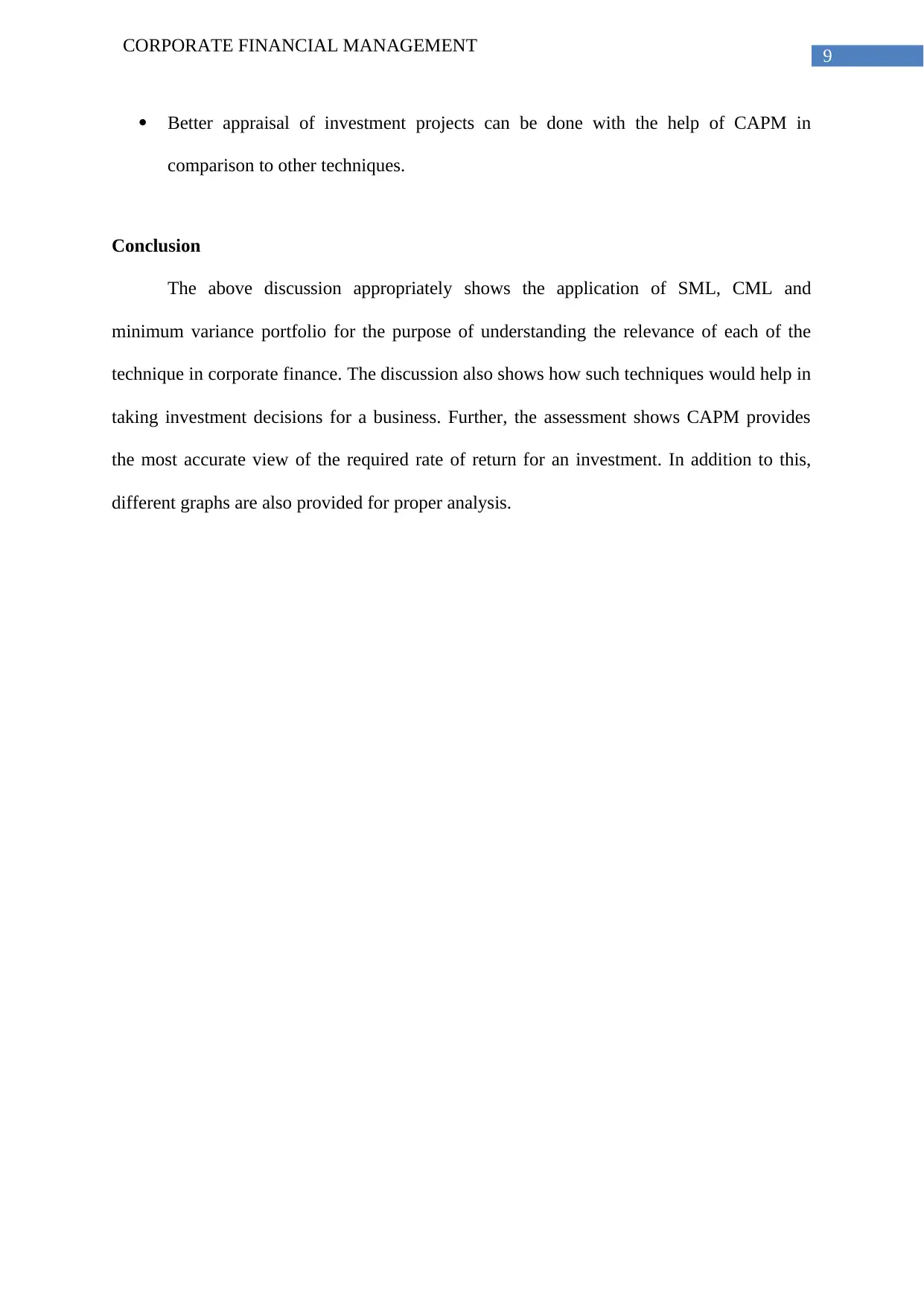
9
CORPORATE FINANCIAL MANAGEMENT
Better appraisal of investment projects can be done with the help of CAPM in
comparison to other techniques.
Conclusion
The above discussion appropriately shows the application of SML, CML and
minimum variance portfolio for the purpose of understanding the relevance of each of the
technique in corporate finance. The discussion also shows how such techniques would help in
taking investment decisions for a business. Further, the assessment shows CAPM provides
the most accurate view of the required rate of return for an investment. In addition to this,
different graphs are also provided for proper analysis.
CORPORATE FINANCIAL MANAGEMENT
Better appraisal of investment projects can be done with the help of CAPM in
comparison to other techniques.
Conclusion
The above discussion appropriately shows the application of SML, CML and
minimum variance portfolio for the purpose of understanding the relevance of each of the
technique in corporate finance. The discussion also shows how such techniques would help in
taking investment decisions for a business. Further, the assessment shows CAPM provides
the most accurate view of the required rate of return for an investment. In addition to this,
different graphs are also provided for proper analysis.
Paraphrase This Document
Need a fresh take? Get an instant paraphrase of this document with our AI Paraphraser
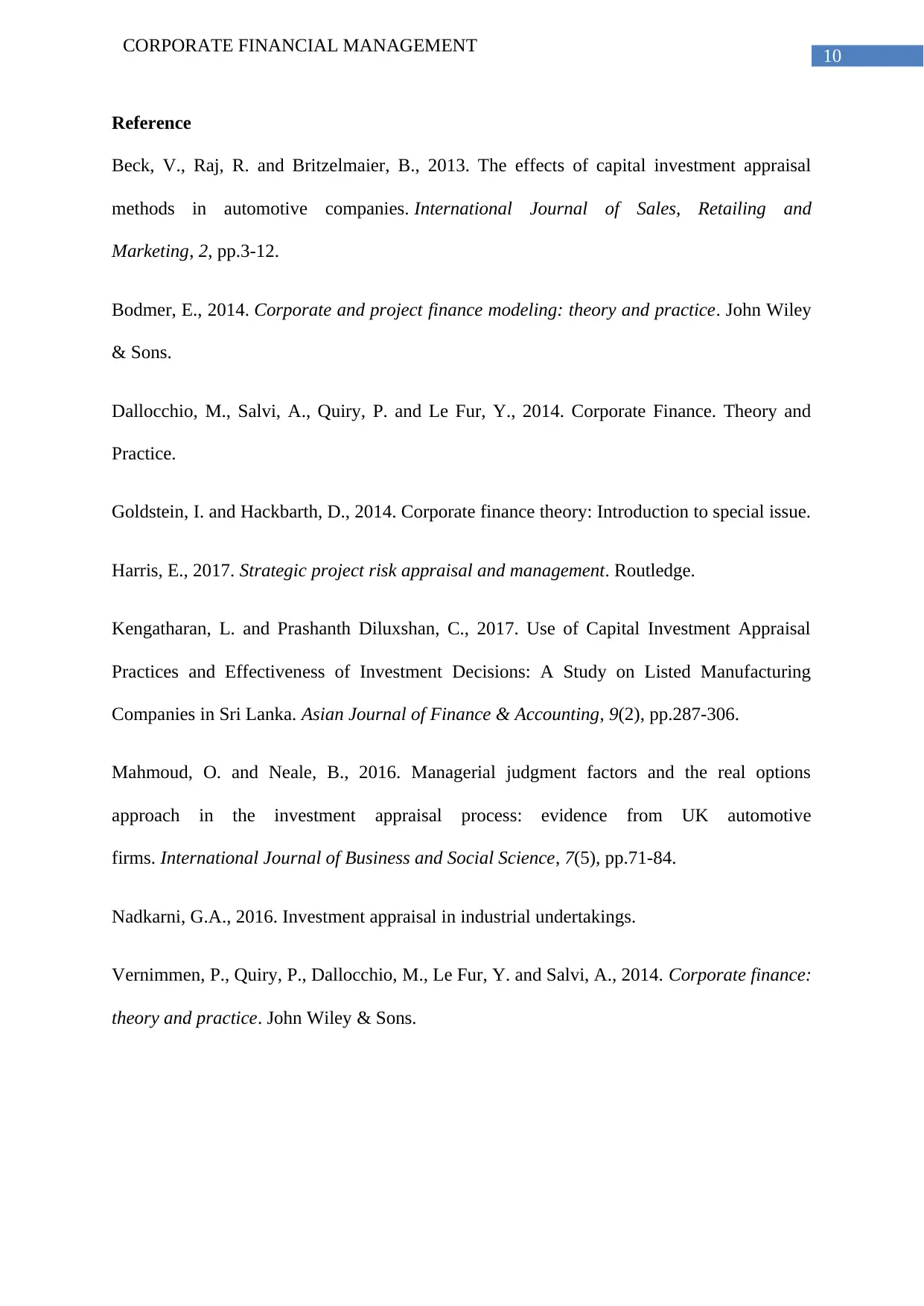
10
CORPORATE FINANCIAL MANAGEMENT
Reference
Beck, V., Raj, R. and Britzelmaier, B., 2013. The effects of capital investment appraisal
methods in automotive companies. International Journal of Sales, Retailing and
Marketing, 2, pp.3-12.
Bodmer, E., 2014. Corporate and project finance modeling: theory and practice. John Wiley
& Sons.
Dallocchio, M., Salvi, A., Quiry, P. and Le Fur, Y., 2014. Corporate Finance. Theory and
Practice.
Goldstein, I. and Hackbarth, D., 2014. Corporate finance theory: Introduction to special issue.
Harris, E., 2017. Strategic project risk appraisal and management. Routledge.
Kengatharan, L. and Prashanth Diluxshan, C., 2017. Use of Capital Investment Appraisal
Practices and Effectiveness of Investment Decisions: A Study on Listed Manufacturing
Companies in Sri Lanka. Asian Journal of Finance & Accounting, 9(2), pp.287-306.
Mahmoud, O. and Neale, B., 2016. Managerial judgment factors and the real options
approach in the investment appraisal process: evidence from UK automotive
firms. International Journal of Business and Social Science, 7(5), pp.71-84.
Nadkarni, G.A., 2016. Investment appraisal in industrial undertakings.
Vernimmen, P., Quiry, P., Dallocchio, M., Le Fur, Y. and Salvi, A., 2014. Corporate finance:
theory and practice. John Wiley & Sons.
CORPORATE FINANCIAL MANAGEMENT
Reference
Beck, V., Raj, R. and Britzelmaier, B., 2013. The effects of capital investment appraisal
methods in automotive companies. International Journal of Sales, Retailing and
Marketing, 2, pp.3-12.
Bodmer, E., 2014. Corporate and project finance modeling: theory and practice. John Wiley
& Sons.
Dallocchio, M., Salvi, A., Quiry, P. and Le Fur, Y., 2014. Corporate Finance. Theory and
Practice.
Goldstein, I. and Hackbarth, D., 2014. Corporate finance theory: Introduction to special issue.
Harris, E., 2017. Strategic project risk appraisal and management. Routledge.
Kengatharan, L. and Prashanth Diluxshan, C., 2017. Use of Capital Investment Appraisal
Practices and Effectiveness of Investment Decisions: A Study on Listed Manufacturing
Companies in Sri Lanka. Asian Journal of Finance & Accounting, 9(2), pp.287-306.
Mahmoud, O. and Neale, B., 2016. Managerial judgment factors and the real options
approach in the investment appraisal process: evidence from UK automotive
firms. International Journal of Business and Social Science, 7(5), pp.71-84.
Nadkarni, G.A., 2016. Investment appraisal in industrial undertakings.
Vernimmen, P., Quiry, P., Dallocchio, M., Le Fur, Y. and Salvi, A., 2014. Corporate finance:
theory and practice. John Wiley & Sons.
1 out of 11
Related Documents
Your All-in-One AI-Powered Toolkit for Academic Success.
+13062052269
info@desklib.com
Available 24*7 on WhatsApp / Email
![[object Object]](/_next/static/media/star-bottom.7253800d.svg)
Unlock your academic potential
Copyright © 2020–2025 A2Z Services. All Rights Reserved. Developed and managed by ZUCOL.




